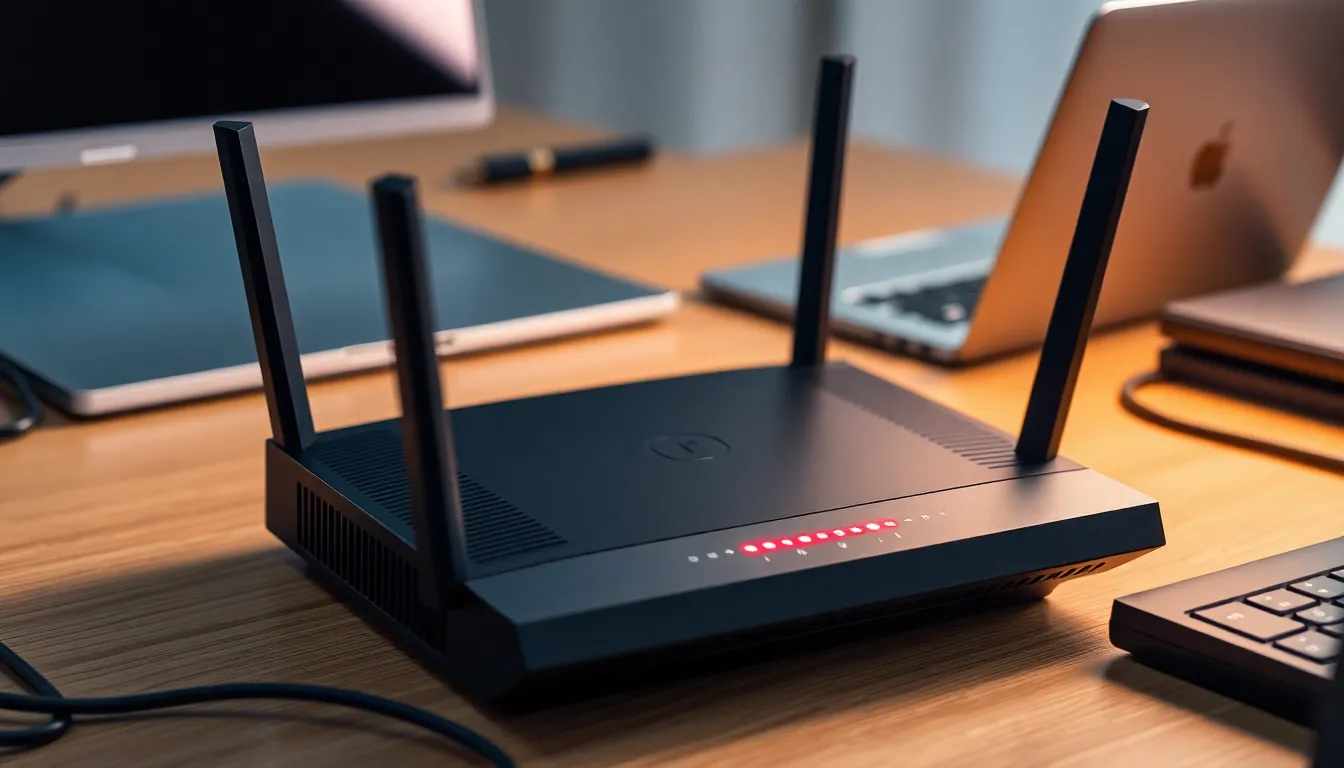In the world of networking, router naming conventions play a crucial role in maintaining organization and efficiency. With countless devices connected to networks, having a clear and consistent naming system helps administrators quickly identify and manage routers. This practice not only simplifies troubleshooting but also enhances overall network security.
Understanding the principles behind router naming can significantly improve network performance. By following established guidelines, network professionals can ensure that their infrastructure remains scalable and manageable. As the complexity of networks continues to grow, adopting effective naming conventions becomes more essential than ever for seamless connectivity and communication.
Table of Contents
ToggleOverview of Router Naming Conventions
Router naming conventions play a crucial role in enhancing network management and efficiency. A well-structured naming system allows network administrators to quickly identify device locations, types, and roles. Consistency in naming conventions reduces confusion and helps streamline troubleshooting processes, ensuring faster resolution of issues.
Established naming conventions often include specific elements that convey vital information. Common components include:
- Location Identifier: The physical location of the router, such as a city name or building code.
- Device Function: An indication of the router’s role, like “Core,” “Edge,” or “Access.”
- Unique Identifier: A unique code or number that distinguishes one device from another in the same location or function.
For example, a router named “NYC-Core-01” indicates it’s the first core router located in New York City. Such clarity assists administrators in managing multiple routers effectively.
Adopting industry best practices ensures scalability and consistent communication among teams. Guidelines may include using standardized abbreviations, limiting character counts for compatibility, and avoiding special characters that can hinder device recognition.
By implementing structured naming conventions, networks can achieve increased security and performance. Effective naming not only enhances day-to-day operations but also facilitates future growth, allowing networks to adapt and expand with minimal disruption.
Importance of Router Naming Conventions

Router naming conventions play a crucial role in networking, primarily by enhancing organization and efficiency. A well-structured naming system facilitates easy identification and management of routers, leading to streamlined operations.
Clarity and Identification
Clarity in router naming ensures easy identification of devices within the network. Names should include relevant components like location, function, and unique identifiers. For example, a router labeled “NYC-Core-01” immediately conveys its location (New York City), its purpose (core router), and its unique position (01) within the network. Such explicit naming improves troubleshooting speed, as network administrators quickly pinpoint devices without sifting through ambiguous names.
Organizational Benefits
Organizational benefits arise from adopting systematic naming conventions. Consistency in naming fosters a clearer understanding among team members, reduces confusion, and standardizes communication. As network complexity increases, a familiar naming structure aids in maintaining order. By following best practices—such as avoiding special characters and utilizing standardized abbreviations—organizations can scale their networks efficiently. Effective naming conventions contribute not only to improved network performance but also enhance overall team collaboration.
Common Router Naming Conventions
Router naming conventions rely on a systematic approach, with alphanumeric patterns and geographic indicators being two key components. These conventions ensure clarity and enable efficient management of network devices.
Alphanumeric Patterns
Alphanumeric patterns create standardized formats for router names, enhancing consistency across networks. Naming convention examples include:
- Device Type: Use abbreviations like “RTR” for router, helping identify device functions quickly.
- Functionality: Incorporate the main role, such as “EDGE,” signifying its position in the network hierarchy.
- Unique Identifiers: Assign unique numbers, like “01” or “02,” distinguishing similar devices.
Creating patterns enables administrators to recognize device roles and locations at a glance, improving troubleshooting accuracy and efficiency.
Geographic Indicators
Geographic indicators provide location context in router names, enhancing organization within expansive networks. Standard practices include:
- City Codes: Use standardized city abbreviations, such as “NYC” for New York City, making it easy to locate devices geographically.
- Building Identifiers: Implement specific building codes, if applicable, aiding in device placement clarity.
- Site Names: Include site designations in names, such as “HQ” for headquarters, improving overall comprehension.
Using geographic indicators ensures quick identification of routers, facilitating rapid responses to network issues while maintaining an organized structure.
Best Practices for Router Naming Conventions
Establishing best practices for router naming conventions enhances organization and management efficiency. Consistency and specification inclusivity are key factors to consider.
Consistency in Naming
Consistency in router naming fosters a streamlined identification process. Maintaining a uniform structure across all router names minimizes errors and confusion among network administrators. Common practices include:
- Standardization: Use predetermined formats for all router names, ensuring uniformity.
- Abbreviations: Adopt a set of agreed-upon abbreviations for device types and functions to simplify names.
- Hierarchical Structure: Implement a logical order in naming, such as location followed by function, to provide clarity.
Adopting these practices ensures that all team members recognize devices quickly, facilitating effective communication and troubleshooting.
Inclusivity of Specifications
Inclusivity of specifications in router names provides critical information at a glance. Incorporating relevant details within the naming convention improves context and management. Essential elements include:
- Geographic Indicators: Include location codes or building identifiers to reflect where the router is situated, enhancing situational awareness.
- Device Roles: Specify the primary function, such as “Core” or “Edge,” to inform users of each router’s purpose within the network.
- Unique Identifiers: Integrate distinct numbers or codes to differentiate similar devices, ensuring clear identification.
By encompassing these specifications, router names deliver comprehensive insights, aiding in efficient network operations and performance monitoring.
Future Trends in Router Naming Conventions
Emerging trends in router naming conventions reflect the evolving demands of modern networking. Increased automation and integration of artificial intelligence within network management systems will dictate a shift toward dynamic naming conventions. These conventions will adapt in real-time, reflecting changes in device roles or network configurations, thus enhancing operational efficiency.
Adoption of machine-readable names stands out as a significant trend. Router names that use structured formats—incorporating metadata and supporting programmability—will enable easier automation of network configurations. For example, implementing naming systems based on device type, location, and operational status will facilitate automated network monitoring processes.
Cloud-based networking solutions also influence naming conventions. As organizations migrate to the cloud, router names must convey information relevant to specific cloud environments. Incorporating cloud service identifiers in the naming structure assists in distinguishing between on-premises and cloud resources, enabling better management of hybrid networks.
Increased focus on cybersecurity will drive the development of more descriptive naming conventions. Routers may include security status indicators within their names, allowing for rapid assessment of vulnerabilities or compliance levels. This practice enhances visibility of potential security issues, promoting timely interventions and improving overall network integrity.
Furthermore, the growing importance of IoT (Internet of Things) devices necessitates specialized naming conventions. Naming will increasingly account for the diversity of IoT devices, emphasizing their functionality and location within the network. This attention to detail enhances clarity and simplifies troubleshooting across interconnected devices.
Sustainability initiatives will likely impact router naming conventions as well. Companies may incorporate eco-friendly identifiers, reflecting efforts to minimize the environmental footprint of their networks. This practice not only promotes sustainability but also reinforces corporate responsibility in the digital landscape.
These trends underscore the need for routers’ naming conventions to evolve, enhancing network organization, management, and security as global networking needs advance.
Effective router naming conventions are essential for maintaining organized and efficient networks. By adopting a clear and consistent naming system, network administrators can streamline device management and enhance troubleshooting efforts. As networks grow in complexity, the importance of structured naming becomes even more pronounced, facilitating improved performance and security.
Future trends indicate a shift towards dynamic naming systems that adapt to automation and cloud-based solutions. Emphasizing clarity and context in router names will support the evolving demands of networking, ensuring seamless operations. Ultimately, prioritizing robust naming conventions not only simplifies current management but also positions networks for future growth and innovation.



